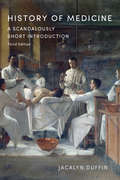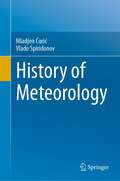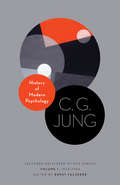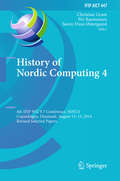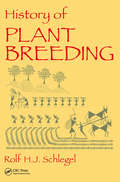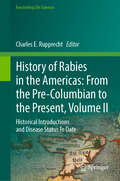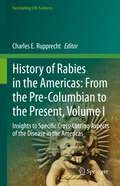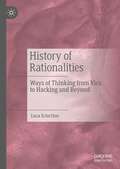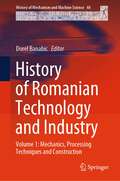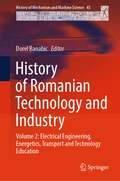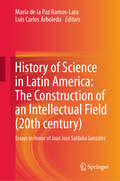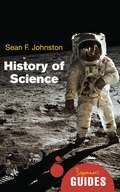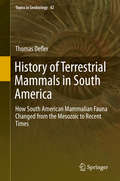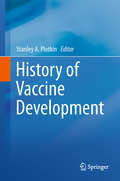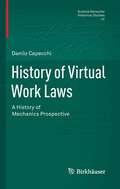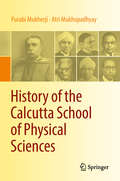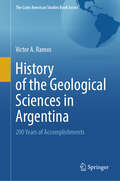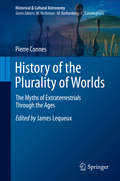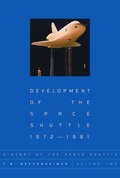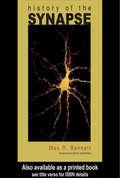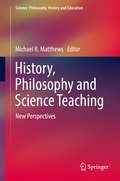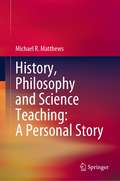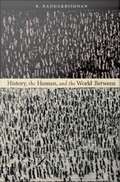- Table View
- List View
History of Medicine: A Scandalously Short Introduction, Third Edition
by Jacalyn DuffinJacalyn Duffin's History of Medicine is one of the leading texts used to teach the history of the medical profession. Emphasizing broad concepts rather than names and dates, it has also been widely appreciated by general readers for more than twenty years. Based on sound scholarship and meticulous research, History of Medicine incorporates pithy examples from a range of periods and places and is infused with the author’s characteristic wit. The third edition has been completely revised to highlight new scholarship on the past and incorporate significant medical events of the most recent decade – including new technologies, drug shortages, medical assistance in dying, and recent outbreaks of infectious diseases such as Ebola, H1N1, Zika, and COVID-19. The book is organized around themes of scientific and clinical interest, such as anatomy, physiology, pharmacology, surgery, obstetrics, medical education, health-care delivery, and public health. It includes a chapter on how to approach research in medical history, updated with new resources. History of Medicine is sensitive to the power of historical research to inform current health-care practice and enhance cultural understanding.
History of Meteorology
by Vlado Spiridonov Mladjen ĆurićThis book provides a detailed history of meteorology as a natural science, from an understanding of the Earth's early atmosphere to present-day advancements. In three parts, the book synthesizes developments in quantitative meteorology starting from its very early stages and progressively covers the invention of basic meteorology instruments while highlighting the various turning points and key figures who played roles along the way. The first part addresses the treatment of meteorology during early civilization. Part two goes into the early development of meteorology as a science. Part three covers the science's rapid progression and present-day status while addressing the primary technologies and methodologies used in a variety of areas like weather forecasting, remote sensing, and radar instrumentation. The target audience for the book is students and researchers interested in the history of meteorology as a science, and also general enthusiasts of the subject who have some background on the topic.
History of Modern Psychology: Lectures Delivered at ETH Zurich, Volume 1, 1933-1934 (Philemon Foundation Series #14)
by C. G. Jung Sonu Shamdasani Ernst Falzeder John Peck Mark Kyburz Ulrich HoerniJung’s lectures on the history of psychology—in English for the first timeBetween 1933 and 1941, C. G. Jung delivered a series of public lectures at the Swiss Federal Institute of Technology (ETH) in Zurich. Intended for a general audience, these lectures addressed a broad range of topics, from dream analysis to yoga and meditation. Here for the first time in English are Jung’s lectures on the history of modern psychology from the Enlightenment to his own time, delivered in the fall and winter of 1933–34.In these inaugural lectures, Jung emphasizes the development of concepts of the unconscious and offers a comparative study of movements in French, German, British, and American thought. He also gives detailed analyses of Justinus Kerner’s The Seeress of Prevorst and Théodore Flournoy’s From India to the Planet Mars. These lectures present the history of psychology from the perspective of one of the field’s most legendary figures. They provide a unique opportunity to encounter Jung speaking for specialists and nonspecialists alike and are the primary source for understanding his late work.Featuring cross-references to the Jung canon and explanations of concepts and terminology, History of Modern Psychology painstakingly reconstructs and translates these lectures from manuscripts, summaries, and recently recovered shorthand notes of attendees. It is the first volume of a series that will make the ETH lectures available in their entirety to English readers.
History of Nordic Computing 4
by Christian Gram Per Rasmussen Søren Duus ØstergaardThis book constitutes the refereed post-proceedings of the 4th IFIP WG 9. 7 Conference on the History of Nordic Computing, HiNC 4, held in Copenhagen, Denmark, in August 2014. The 37 revised full papers were carefully reviewed and selected for inclusion in this volume. The papers focus on innovative ICT milestones that transformed the nordic societies and on the new ideas, systems and solutions that helped creating the welfare societies of today, in particular solutions and systems for public services, e. g. , tax, social benefits, health care and education; solutions and systems for the infrastructure of the society, e. g. , banking, insurance, telephones, transport and energy supply; and technologies and IT policies behind the major IT milestones, e. g. , user centric innovation, programming techniques and IT ethics. They are organized in topical sections on IT policy, infrastructure, public services, private services, telesystems, health care, IT in banking, transport and IT technology.
History of Plant Breeding
by Rolf H. SchlegelWhile there has been great progress in the development of plant breeding over the last decade, the selection of suitable plants for human consumption began over 13,000 years ago. Since the Neolithic era, the cultivation of plants has progressed in Asia Minor, Asia, Europe, and ancient America, each specific to the locally wild plants as well as the ecological and social conditions. A handy reference for knowing our past, understanding the present, and creating the future, this book provides a comprehensive treatment of the development of crop improvement methods over the centuries. It features an extensive historical treatment of development, including influential individuals in the field, plant cultivation in various regions, techniques used in the Old World, and cropping in ancient America. The advances of scientific plant breeding in the twentieth century is extensively explored, including efficient selection methods, hybrid breeding, induced polyploidy, mutation research, biotechnology, and genetic manipulation. Finally, this book presents information on approaches to the sustainability of breeding and to cope with climatic changes as well as the growing world population.
History of Rabies in the Americas: Historical Introductions and Disease Status To Date (Fascinating Life Sciences)
by Charles E. RupprechtRabies is one of the oldest known pathogens, is incurable, and has the highest fatality rate of all infectious diseases. The Americas is the only region with bat rabies virus, including vampire bat rabies. The region is rich in cultural references and notable for many discoveries in the field, including the current vaccine potency test, diagnostic assay, conception of oral vaccines for wildlife, the first human survivor and the first successful canine rabies program executed at a broad level. Rabies remains the most important viral zoonosis, with tens of thousands of human fatalities and tens of millions of exposures annually, which can be used to model for other pathogens, such as COVID-19. There is an international effort to eliminate human rabies caused by dogs over the next decade, and the Americas represent the primary region with the greatest proof-of-concept evidence to accomplish this goal. This two-volume set addresses the medical history and modern results of rabies in countries throughout the Americas, including the implications of and on cultural, economic, sociological, and research developments in the region. Volume II provides an in-depth analysis of the rabies' presence and impact in specific countries, including historical perspectives, advances in research and understanding, and current status.
History of Rabies in the Americas: Insights to Specific Cross-Cutting Aspects of the Disease in the Americas (Fascinating Life Sciences)
by Charles E. RupprechtRabies is one of the oldest known pathogens, is incurable, and has the highest fatality rate of all infectious diseases. The Americas is the only region with bat rabies virus, including vampire bat rabies. The region is rich in cultural references and notable for many discoveries in the field, including the current vaccine potency test, diagnostic assay, conception of oral vaccines for wildlife, the first human survivor and the first successful canine rabies program executed at a broad level. Rabies remains the most important viral zoonosis, with tens of thousands of human fatalities and tens of millions of exposures annually, which can be used to model for other pathogens, such as COVID-19. There is an international effort to eliminate human rabies caused by dogs over the next decade, and the Americas represent the primary region with the greatest proof-of-concept evidence to accomplish this goal. This two-volume set addresses the medical history and modern results of rabies in countries throughout the Americas, including the implications of and on cultural, economic, sociological, and research developments in the region. Volume I presents an overview of concepts critical to the study of rabies in the region, including evolutionary aspects, reservoir ecology and control, elimination efforts, vaccine development, and disease hallmarks and progression. It also analyzes the long-term cultural, social, and economic impacts of the disease in the Americas.
History of Rationalities: Ways of Thinking from Vico to Hacking and Beyond
by Luca SciortinoOver time, philosophers and historians of science have introduced different notions of 'ways of thinking'. This book presents, compares, and contrasts these different notions. It focuses primarily on Ian Hacking’s idea of 'style of reasoning' in order to assess and develop it into a more systematic theory of scientific thought, arguing that Hacking’s theory implies epistemic relativism. Luca Sciortino also discusses the implications of Hacking’s ideas for the study of the problem of contingency and inevitability in the development of scientific knowledge
History of Romanian Technology and Industry: Volume 1: Mechanics, Processing Techniques and Construction (History of Mechanism and Machine Science #44)
by Dorel BanabicThis volume showcases the valuable achievements of the Romanian technology and industry worldwide. It started from the premise that the history of Romanian technique is scarcely known outside the borders of Romania. The main Romanian contributions to the world’s technological heritage are missing, except for a few names in the field of aviation, from the great encyclopedias and dictionaries published worldwide. This is due, among other reasons, to the insufficient promotion in widely spoken languages of the history of Romanian technology. The multidisciplinary approach of the volumes means that the field of technology had to be split into several branches. The present volume includes the following industries: mining, metallurgy, oil, natural gas, machine building, agricultural machinery, military, textiles, and construction. Folk technology, the formation of the industrial system, and mechanics are tackled in separate chapters. For each field, are engaged the collaboration of authors who have already published a history of their field. Certain chapters were drafted with the aid of specialists who have played the part of policy makers in the elaboration of development strategies for Romania and who are familiar not only with the facts and the history of their field, but also with the ‘philosophy’ behind its development.
History of Romanian Technology and Industry: Volume 2: Electrical Engineering, Energetics, Transport and Technology Education (History of Mechanism and Machine Science #45)
by Dorel BanabicThis volume showcases the valuable achievements of the Romanian technology and industry worldwide. It started from the premise that the history of Romanian technique is scarcely known outside the borders of Romania. The main Romanian contributions to the world’s technological heritage are missing, except for a few names in the field of aviation, from the great encyclopedias and dictionaries published worldwide. This is due, among other reasons, to the insufficient promotion in widely spoken languages of the history of Romanian technology. The multidisciplinary approach of the volumes means that the field of technology had to be split into several branches. The present volume includes the following industries: electrical engineering, energy technology, biomedicine, maritime and rail transport, automotive industry, aviation. The history of engineering societies, of engineering education, of intellectual property, and of inventions, as well as a synopsis of the personalities of Romanian engineering have been tackled in separate chapters. For each field, are engaged the collaboration of authors who have already published a history of their field. Certain chapters were drafted with the aid of specialists who have played the part of policy makers in the elaboration of development strategies for Romania and who are familiar not only with the facts and the history of their field, but also with the ‘philosophy’ behind its development.
History of Science in Latin America (20th century): Essays in Honor of Juan José Saldaña González
by María de la Paz Ramos-Lara Luis Carlos ArboledaThis book provides a unique analysis of how the History of Science became institutionalized in Latin America during the last two decades of the 20th century. It examines the establishment of the first Latin American community in the History of Science and its connections with the international community and various international institutions, such as the International Union of History and Philosophy of Science and Technology / Division of History of Science and Technology (IUHPST/DHST). The authors are the same scholars who have been involved in several activities and strategies to professionalize and institutionalize this field in Latin America. They explore the impact of Western educational institutions and theoretical and methodological perspectives on the introduction of the History of Science in several Latin American nations. The book examines the two-way movement of European scholars to Latin America and Latin American students mainly to France. At that time, the organization of congresses in France, Spain, the United States, and other European countries encouraged the participation of Latin American historians of science. Notable events include the Science and Empires congress in Paris (1990), the Ciencia, descubrimiento y mundo colonial conference in Madrid (1991), and the International Congresses of History of Science and Technology (ICHST). The authors refer to seven Latin Americans who signed the Declaration of Bucharest (1981) to promote the history of sciences in their countries. This initiative led to the establishment of the Latin American Society for the History of Science and Technology (LASHST) in 1982, under the leadership of Juan José Saldaña, director of Quipu and Cuadernos de Quipu. With his leadership, existing national societies were reactivated, and new ones were created, up to ten in four years: Argentina, Brazil, Colombia, Mexico, Chile, Peru, Venezuela, Costa Rica, Ecuador, and Cuba. This effort internationally legitimized Latin American scientific practice, culminating in celebrating the XXI ICHST in Mexico City in 2001. He founded the International Association for Scientific Cultural Diversity (IASCUD) and became the first Latin American to serve as Secretary General of IUHPST/DHS from 2001 to 2005. Through his various actions and activities, Saldaña and the LASHST community were able to promote the institutionalization of the History of Science in Latin America. This book pays a well-deserved tribute to his efforts.
History of Science: A Beginner's Guide (Beginner's Guides)
by Sean F. JohnstonEmploying intellectual history, philosophy, and social studies, Sean Johnston offers a unique appraisal of the history of science and the nature of the evolving discipline. Science is all-encompassing and contentious. Based on its past, where might it lead in the twenty-first century? Sean F. Johnston is a reader in the History of Science and Technology at the University of Glasgow.
History of Terrestrial Mammals in South America: How South American Mammalian Fauna Changed From The Mesozoic To Recent Times (Topics in Geobiology #42)
by Thomas DeflerThis book takes a non-technical approach in covering the evolution of South American mammalian fauna throughout geological history, and discusses how South America has changed due to mammalian invasions. Unlike other works on the subject, this book attempts to answer several crucial questions that often go unmentioned together in one cohesive monograph. What was the fauna like before the American interchange? What were the origins of the now-extinct groups when northern species arrived and out-competed them? How did the modern mammalian fauna come into being with such disparate animal groups? This information is given from a historical perspective throughout the book's 15 chapters, and is presented in an easily graspable fashion by mostly avoiding technical language. The book is written for academics, scientists and scholars engaged in paleontology, zoology and evolutionary biology, but may also appeal to a larger audience of general readers interested in mammalian evolution. The book begins with an introduction, describing the tools necessary to interpret the evolutionary history of South American mammals in geological terms and some of the early people who helped found South American mammalian paleontology. Chapter 2 describes the Mesozoic first mammals of Gondwana and what we are learning about them, dominant before the K/T extinction event. Then chapters 3 through 8 cover the Cenozoic, or "Age of Mammals", highlighting the major mammalian groups of South America that replaced the earlier mammals of Gondwana. These groups include the marsupials, native ungulates, the xenarthrans (armadillos, anteaters, sloths), the caviomorphs (rodents), and the platyrrhine monkeys. Chapters 9 and 10 address the Antarctic La Meseta fossils and the Colombian La Venta fossil faunal assemblages. Chapter 11 discusses the neotropical mammals that invaded the Caribbean Islands, and illustrates the influence South America has had on adjacent faunas. Chapter 12 describes the origin of the Amazon River and the role it has played in the evolution of the mammals and other flora and fauna. Chapter 13 tells the story of the Great American Biotic Interchange (GABI), and chapter 14 follows this up with a discussion of the Pleistocene mammal communities and their eventual extinction. Chapter 15 concludes the text by discussing the modern mammals of South America, and how despite the extensive Pleistocene extinctions there is still a lot of mammalian diversity in South America.
History of Vaccine Development
by Stanley A. PlotkinVaccinology, the concept of a science ranging from the study of immunology to the development and distribution of vaccines, was a word invented by Jonas Salk. This book covers the history of the methodological progress in vaccine development and to the social and ethical issues raised by vaccination. Chapters include "Jenner and the Vaccination against Smallpox," "Viral Vaccines," and "Ethical and Social Aspects of vaccines." Contributing authors include pioneers in the field, such as Samuel L. Katz and Hilary Koprowski. This history of vaccines is relatively short and many of its protagonists are still alive. This book was written by some of the chief actors in the drama whose subject matter is the conquest of epidemic disease.
History of Virtual Work Laws
by Danilo CapecchiThe book presents a history of classical mechanics by focusing on issues of equilibrium. The historical point of view adopted here restricts attention to cases where the effectiveness of forces is assessed on the basis of the virtual motion of their points of application. For completeness, hints of the alternative approach are also referred, the Archimedean for ancient mechanics and the Newtonian for modern mechanics. The laws resulting from consideration of virtual motions are named laws of virtual work. The modern formulations of the principle of virtual work are only a particular form of them. The book begins with the first documented formulations of laws of virtual work in the IV century BC in Greece and proceeds to the end of the XIX century AD in Europe. A significant space is devoted to Arabic and Latin mechanics of Middle Ages. With the Renaissance it began to appear slightly different wordings of the laws, which were often proposed as unique principles of statics. The process reached its apex with Bernoulli and Lagrange in the XVIII century. The book ends with some chapters dealing with the discussions that took place in the French school on the role of the Lagrangian version of the law of virtual work and its applications to continuum mechanics.
History of the Calcutta School of Physical Sciences
by Purabi Mukherji Atri MukhopadhyayThis book highlights the role of Sir Asutosh Mookerjee, founder of the Calcutta school of physics and the Calcutta Mathematical Society, and his talented scholars – Sir C.V. Raman, D.M. Bose, S.N. Bose, M.N. Saha, Sir K.S. Krishnan and S.K. Mitra – all of whom played a significant role in fulfilling their goal of creating an outstanding school of physical sciences in the city of Calcutta. The main objective of the book is to bring to the fore the combined contributions of the greatest physicists of India, who in the colonial period worked with practically no modern amenities and limited financial resources, but nonetheless with total dedication and self-confidence, which is unmatched in today’s world. The book presents the golden age of the physical sciences in India in compact form; in addition, small anecdotes, mostly unknown to many, have been brought the forefront. The book consists of 10 chapters, which include papers by these distinguished scientists along with detailed accounts of their academic lives and main research contributions, particularly during their time in Calcutta. A synopsis of the contents is provided in the introductory chapter. In the following chapters, detailed discussions are presented in straightforward language. The complete bibliographies of the great scientists have been added at the end. This book will be of interest to historians, philosophers of science, linguists, anthropologists, students, research scholars and general readers with a love for the history of science.
History of the Geological Sciences in Argentina: 200 Years of Accomplishments (The Latin American Studies Book Series)
by Victor A. RamosThe science of geology is intertwined with the growth of the field in Argentina. This book explores those dual historical developments and, as an expanded translation of Historia de la Geología Argentina: Una Crónica de Más de Dos Siglos, shares them with a global audience. Drawing on the author's extensive work throughout the country as well as documents and photographs from the archives of the National Geological Survey, General Archive of the Nation, and the universities of Buenos Aires, Córdoba, and La Plata, this book offers a once-in-a-century look at developments in the field of geology from a country-specific perspective.
History of the Plurality of Worlds: The Myths of Extraterrestrials Through the Ages (Historical & Cultural Astronomy)
by Pierre ConnesModern research has demonstrated that many stars are surrounded by planets—some of which might contain the right conditions to harbor life. This has only reinforced a question that has been tormenting scientists, philosophers and priests since Antiquity: Are there other inhabited worlds beyond our own?This book analyzes the many ways that humans have argued for and depicted extraterrestrial life over the centuries. The first known texts about the subject date from as early as the 6th century BC. Since that time, countless well-known historical characters like Lucretius, Aristotle, Thomas Aquinas, Cusanus, Bruno, Kepler, Descartes, and Huygens contributed to the debate; here, their lesser known opinions on the subject are studied in detail.It is often difficult for the modern mind to follow the thinking of our ancestors, which can only be understood when placed in the relevant context. The book thus extends its scope to the evolution of ideas about cosmology in general, as well as the culture in which these great thinkers wrote. The research is presented with the author's insights and humor, making this an easy and enjoyable read.
History of the Space Shuttle, Volume Two
by T. A. HeppenheimerBasing his work on virtually untapped NASA archives, T. A. Heppenheimer has produced the second volume of his definitive history of the space shuttle. Volume Two traces the development of the shuttle through a decade of engineering setbacks and breakthroughs, program-management challenges, and political strategizing, culminating in the first launch in April 1981. The focus is on the engineering challenges--propulsion, thermal protection, electronics, onboard systems--and the author covers in depth the alternative vehicles developed by the U.S. Air Force and European countries. The first launch entailed a monumental amount of planning and preparation that Heppenheimer explains in detail.
History of the Synapse
by Max R. BennettThe History of the Synapse provides a history of those discoveries concerning the identification and function of synapses that provide the foundations for research during this new century with a personal view of the process by which new concepts have developed. Previously published as essays, the chapters in this book provide a history of various a
History of the Warfare of Science with Theology in Christendom
by Andrew Dickson WhiteWallpaper* City Guidesnot only suggest where to stay, what to eat, and what to drink, but what the tourist passionate about design might want to see, whether he or she has a week or just 24 hours in the city. <P> <P> Some of the highlights include up-and-coming neighborhoods, an `Architour? of landmark buildings, design centers, and the best shops to buy unique items. Wallpaper* City Guidespresent travelers with a fast-track ticket to the chosen location. The tightly-edited guides offer the best, most exciting, and the most beautiful of the featured city. The guides are expertly designed with function as a priority, and they have tabbed sections so that readers can find information easily. The guides include currency rate information, maps, and a color-coding system to help the reader navigate through different parts of the city. They are the ultimate combination of form and function. The guides are compiled byWallpaper*magazine experts and their extraordinary network of international correspondents. The writers have put their heads together to come up with fascinating, efficient guides for the hip, urban traveler with his or her finger on the pulse. They are truly the insider's guide to each featured city. The firstWallpaper* City Guideswere published in Fall 2006 on the occasion ofWallpaper*?sfirst anniversary. For more than a decade,Wallpaper*has been the first to uncover and enticingly present the best urban travel spots from across the globe. The City Guides are the perfect way to present a decade of experience in one precisely edited guide. As of early 2010, there are 80 city guides available, with seven more on the way by the end of the year.
History, Philosophy and Science Teaching
by Michael R. MatthewsProduced by the Ontario Institute for Studies in Education, this inaugural volume in a new series contains 17 articles (most previously published) by historians, philosophers, psychologists, natural scientists, and science educators who advocate the teaching of science from a broader view in order to improve students' perception of the discipline, increase the development of critical skills, and retain a greater number of students in the field. Annotation copyrighted by Book News, Inc. , Portland, OR
History, Philosophy and Science Teaching: A Personal Story
by Michael R. MatthewsThis book is an historical narrative of academic appointments, significant personal and collaborative research endeavours, and important editorial and institutional engagements. For forty years Michael Matthews has been a prominent international researcher, author, editor and organiser in the field of ‘History, Philosophy and Science Teaching’. He has systematically brought his own discipline training in science, psychology, philosophy of education, and the history and philosophy of science, to bear upon theoretical, curricular and pedagogical issues in science education. The book includes accounts of philosophers who greatly influenced his own thinking and who also were personal friends – Wallis Suchting, Abner Shimony, Robert Cohen, Marx Wartofsky, Israel Scheffler, Michael Martin and Mario Bunge. It advocates the importance of clear writing and avoidance of faddism in both philosophy and in education. It concludes with a proposal for informed and enlightened science teacher education.
History, the Human, and the World Between
by R. RadhakrishnanHistory, the Human, and the World Between is a philosophical investigation of the human subject and its simultaneous implication in multiple and often contradictory ways of knowing. The eminent postcolonial theorist R. Radhakrishnan argues that human subjectivity is always constituted "between": between subjective and objective, temporality and historicity, being and knowing, the ethical and the political, nature and culture, the one and the many, identity and difference, experience and system. In this major study, he suggests that a reconstituted phenomenology has a crucial role to play in mediating between generic modes of knowledge production and an experiential return to life. Keenly appreciative of poststructuralist critiques of phenomenology, Radhakrishnan argues that there is still something profoundly vulnerable at stake in the practice of phenomenology. Radhakrishnan develops his rationale of the "between" through three linked essays where he locates the terms "world," "history," "human," and "subject" between phenomenology and poststructuralism, and in the process sets forth a nuanced reading of the politics of a gendered postcolonial humanism. Critically juxtaposing the works of thinkers such as Friedrich Nietzsche, Adrienne Rich, Frantz Fanon, Edward Said, Michel Foucault, Maurice Merleau-Ponty, Martin Heidegger, David Harvey, and Ranajit Guha, Radhakrishnan examines the relationship between systems of thought and their worldly situations. History, the Human, and the World Between is a powerful argument for a theoretical perspective that combines the existential urgency of phenomenology with the discursive rigor of poststructuralist practices.
